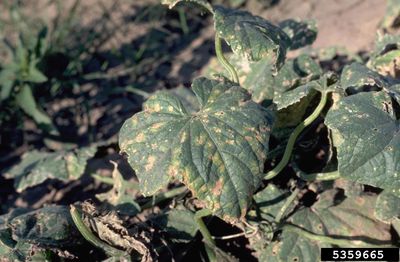What is Angular Leaf Spot?
Angular leaf spot is a bacterial infection that affects cucurbit plants. The offending bacterium is called Pseudomonas syringae. The infection may take hold in any cucurbit, but it is most common in cucumbers, honeydew melons, and zucchini. Other melons, squashes, and pumpkins may be infected, but this is less common. The conditions in which the infection thrives are humid and moist. It is most likely to spread after a big rain or with the use of overhead irrigation. During warm, rainy weather in the summer is when cucurbit angular leaf spot is most likely to take hold.
Signs of Cucurbit Angular Leaf Spot
The infection begins with lesions on the leaves that are water soaked. They will then turn gray to brown in color and are limited by veins in the leaves, hence the angular description and appearance of the lesions. When the leaves dry out, the affected leaf tissue crumbles and leaves an angular hole in the leaf. This leaves the plant looking tattered. Lesions may grow on the fruits as well, but these are usually superficial.
Angular Leaf Spot Control
Try cultural control for angular leaf spot of cucurbits before trying chemicals to eradicate the infection. Before you ever put any cucurbits in your garden, look for varieties that are resistant to angular leaf spot; many are available. How you water your garden also makes a difference. Instead of watering overhead, use drip irrigation. Crop rotation helps as well. Rotate cucurbits with other vegetables that are not susceptible to the infection each year. If you have signs of infection in your cucumbers this year, remove the affected foliage and dispose of it, but don’t add it to your compost. You can also till the leaf litter deep into the soil to help it break down. If you can’t seem to shake the infection, try a bactericide. An early infection may respond to copper sprays.
